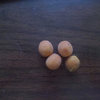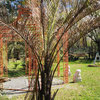Sub-Speicies of Trachycarpus fortunei
Trachycarpus fortune , in a scientific sense,is a general name for all its sub-species including Trachycarpus fortune cv Chusan, Trachycarpus fortunei cv Tesan and Trachycaprus fortune var Winsan,etc. When people normally talk about Trachycaprus fortune, it refers to the most common T.fortunei cv Chusan.
Trachycarpus fortune is native to China with a cultivation history of thousands of years and right now is commonly seen around the word. When it comes to the cultivation practice in China, it has several categories or sub-species according to the trunk, leave and hair, cold hardiness serving different functions and uses. The classification is as follows for reference.
1. Trachycarpus fortune cv Tesan (rarely seen in the market) :
It is a good new rare species , famous for its cold hardiness -20C.
2. Trachycaprus fortune cv Chusan ( most commonly seen in the market):
It is the most common one we see in life and exporation to abroad from China.
3. Trachycarpus fortunei var Winsan (rarely seen in cultivation) :
what makes them special is that they have full round leave with segments making a full round shape as compared to the 1/2 or 3/4 shape seen in other species.
4. Trachycarpus fortune var Misan (only seen in some wild mountains) :
The interesting thing about them is they have elegant small leaves shifting from yellow to green , only about 1/2- 3/4 of the size of T.fortunei leave.
5. Trachycarpus fortune cv Hasan ( not so commonly seen)
It is like Trachycapru fortune cv Tesan in term of the trunk
Its hair is kind of fragile and easy breaking .
Here is a link that might be useful: Photos of Trachycarpus fortunei sub-species including tesan








southern_il_boy
blondboy47
Related Professionals
Tempe Landscape Architects & Landscape Designers · Montgomeryville Landscape Architects & Landscape Designers · Quincy Landscape Architects & Landscape Designers · Saint Louis Park Landscape Architects & Landscape Designers · Taylorsville Landscape Architects & Landscape Designers · Canton Landscape Contractors · Essex Landscape Contractors · Forest Hills Landscape Contractors · Lakeville Landscape Contractors · Lehigh Acres Landscape Contractors · Mission Landscape Contractors · Pahrump Landscape Contractors · Paramount Landscape Contractors · San Bruno Landscape Contractors · Opa Locka Window Contractorsmike-jaramillo
southern_il_boy
mike-jaramillo
flattie
garryendsonOriginal Author
flattie
JohnnieB
cactusfreak